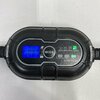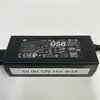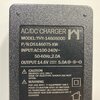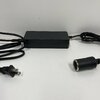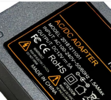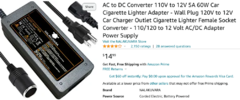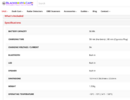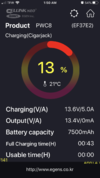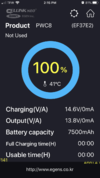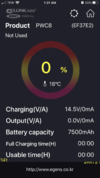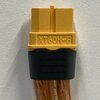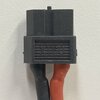Panzer Platform
Well-Known Member
- Joined
- Jun 9, 2022
- Messages
- 2,851
- Reaction score
- 2,813
- Location
- California
- Country
- United States
- Dash Cam
- 2024 Minimum Requirements: STARVIS 2 & HDR
Solar Panel Charging Test
Can the PC8 be charged with a Solar Battery Charger is a question I’ve had for over a year. I just happen to have a 50W solar panel, and MPPT charge controller on hand that was sent to me for test, and review by Allto Solar. The MPPT charge controller is a smart little guy. It can charge Regular Flooded, AGM, and Lithium batteries. The solar panel, and charge controller is capable of delivering a safe & regulated 14.6 Volts @ 3.1 Amps. These figures are very close the the BBMC power inverter for charging the PC8 in the house (14.6 Volts @ 5.0 Amps).
I could not contain my curiosity to see if it could charge the PC8 with Helios particles coming from 8.3 minutes away.
I selected the low 5 Amp charging profile, and hooked up my solar panel with the MPPT charge controller in 100% direct sunlight. The PC8 powered up, and began the BMS (battery management system) “hand shake registration procedure”. After a few seconds of “thinking” the PC8 shut off, and began an endless loop of trying to enter a charge a charge cycle.
It appears I’ve been foiled again by the wits of the PC8’s BMS. It appears my meager 3.1 Amps of solar current does not satisfy the PC8’s minimum charging amperage of 5.0 Amps. Great Scott! I will now attempt to built a terminal on the a clock tower to harness the necessary 1.21 Gigawatts to charge the PC8. Just kidding. Lol
It appears if you want to charge the PC8 with a solar panel you will need a 100 Watt panel to generate the minimum 5.0 Amp requirement to over come the BMS to begin the charging cycle. Que the Price Is Right loosing horn.
This failed attempt at solar charging gives me an idea for my wish list of improvements for the PC8 Gen 2 Model. I would like to see a 3rd charging profile that will allow the use of solar panels from 10 Watts to 100 Watts. A small $20 10 Watt panel could be used to “trickle, or maintain” the PC8’s full charge status in a parking mode situation. 5 Watts to run the dash cam, and an extra 5 watts to keep the PC8 topped up during the day. This would enable the PC8 to have a much longer run time because it will only be discharging by powering the dash cam at night. This might work for folks that want extended parking mode operation like leaving their car in an airport parking lot, or similar.
-Chuck
-
Can the PC8 be charged with a Solar Battery Charger is a question I’ve had for over a year. I just happen to have a 50W solar panel, and MPPT charge controller on hand that was sent to me for test, and review by Allto Solar. The MPPT charge controller is a smart little guy. It can charge Regular Flooded, AGM, and Lithium batteries. The solar panel, and charge controller is capable of delivering a safe & regulated 14.6 Volts @ 3.1 Amps. These figures are very close the the BBMC power inverter for charging the PC8 in the house (14.6 Volts @ 5.0 Amps).
I could not contain my curiosity to see if it could charge the PC8 with Helios particles coming from 8.3 minutes away.
I selected the low 5 Amp charging profile, and hooked up my solar panel with the MPPT charge controller in 100% direct sunlight. The PC8 powered up, and began the BMS (battery management system) “hand shake registration procedure”. After a few seconds of “thinking” the PC8 shut off, and began an endless loop of trying to enter a charge a charge cycle.
It appears I’ve been foiled again by the wits of the PC8’s BMS. It appears my meager 3.1 Amps of solar current does not satisfy the PC8’s minimum charging amperage of 5.0 Amps. Great Scott! I will now attempt to built a terminal on the a clock tower to harness the necessary 1.21 Gigawatts to charge the PC8. Just kidding. Lol
It appears if you want to charge the PC8 with a solar panel you will need a 100 Watt panel to generate the minimum 5.0 Amp requirement to over come the BMS to begin the charging cycle. Que the Price Is Right loosing horn.
This failed attempt at solar charging gives me an idea for my wish list of improvements for the PC8 Gen 2 Model. I would like to see a 3rd charging profile that will allow the use of solar panels from 10 Watts to 100 Watts. A small $20 10 Watt panel could be used to “trickle, or maintain” the PC8’s full charge status in a parking mode situation. 5 Watts to run the dash cam, and an extra 5 watts to keep the PC8 topped up during the day. This would enable the PC8 to have a much longer run time because it will only be discharging by powering the dash cam at night. This might work for folks that want extended parking mode operation like leaving their car in an airport parking lot, or similar.
-Chuck

